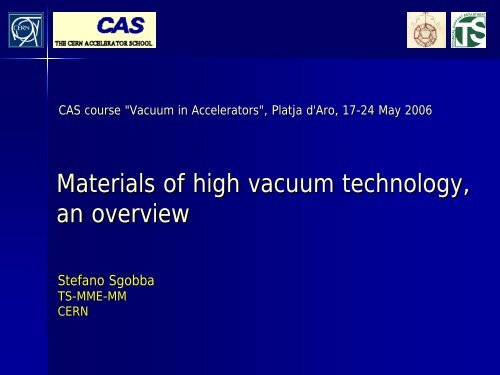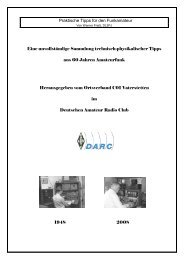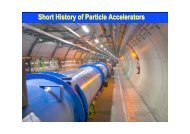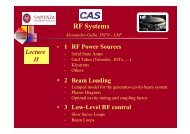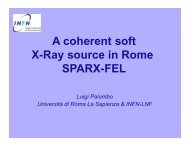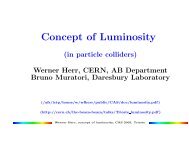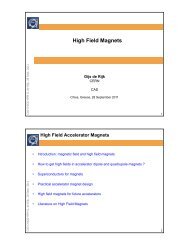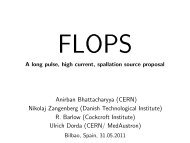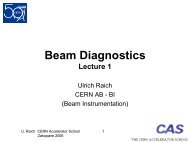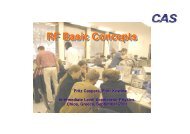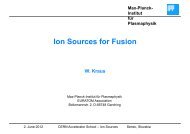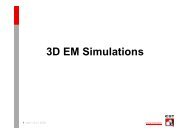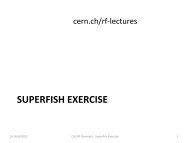Cold-Mass to Cryostat Mechanical Interface - CERN Accelerator ...
Cold-Mass to Cryostat Mechanical Interface - CERN Accelerator ...
Cold-Mass to Cryostat Mechanical Interface - CERN Accelerator ...
You also want an ePaper? Increase the reach of your titles
YUMPU automatically turns print PDFs into web optimized ePapers that Google loves.
CAS course "Vacuum in Accelera<strong>to</strong>rs",<br />
Accelera<strong>to</strong>rs",<br />
Platja d'Aro d'Aro,<br />
, 17-24 17 24 May 2006<br />
Materials of high vacuum technology,<br />
an overview<br />
Stefano Sgobba<br />
TS-MME-MM<br />
<strong>CERN</strong>
Outline<br />
1. General rules for the selection and specification of quality materials materials<br />
for vacuum technology; an his<strong>to</strong>rical perspective<br />
2. The main families of metals and alloys used in vacuum technology:<br />
technology:<br />
from production processes <strong>to</strong> the final inspections<br />
⇒ Discussion of<br />
a) a) Stainless Stainless steels steels<br />
b) b) Aluminium Aluminium and and alloys alloys<br />
c) c) Copper Copper and and alloys alloys<br />
d) d) Other Other and and less less common common materials materials (and (and processes)<br />
processes)<br />
Examples of application<br />
Aspects related <strong>to</strong> manufacturing, joining, near net shaping techniques<br />
techniques<br />
Failure analyses, including corrosion issues...<br />
3. Conclusions<br />
30/05/2006 Special <strong>CERN</strong> Accelera<strong>to</strong>r School 2
General rules<br />
1. Ease of degassing<br />
2. Adequate strength at high as well as low T<br />
3. Thermal expansion coefficients<br />
1. Ease of machinability and joining<br />
4. The purity of the material<br />
2. Sealing glasses, ceramics and other insula<strong>to</strong>rs<br />
5. Exact knowledge of the material properties, critical<br />
3. Materials selection, <strong>to</strong> careful yield low control<br />
outgassing rates<br />
6. 4. Bakeability<br />
Very constant properties of the raw materials, <strong>to</strong> be<br />
5. Interdependence specially prepared<br />
of cleaning, joining, construction and<br />
7. application<br />
Ease of fabrication and cost of vacuum materials are<br />
6. Stainless often of steel secondary is the dominant importance material<br />
(sic !)<br />
((Espe (O'Hanlon, Espe, O'Hanlon, , Materials Materials A A User's User's of of High High guide guide Vacuum Vacuum <strong>to</strong> <strong>to</strong> Vacuum Vacuum technology, technology, Technology, Technology, vol. vol. 1, 1, Wiley, Wiley, Pergamon<br />
Pergamon 2003)<br />
2003<br />
Press, Press, 1966) 1966)<br />
30/05/2006 Special <strong>CERN</strong> Accelera<strong>to</strong>r School 3
A look in<strong>to</strong> the his<strong>to</strong>rical developments of<br />
Espe, 1966<br />
materials for vacuum devices<br />
Kohl, 1967<br />
Ti, Zr, Hf and alloys<br />
Ta, Nb and alloys<br />
Ta, Nb and alloys<br />
Mo and alloys<br />
Mo<br />
Polymers<br />
W and alloys and alloys<br />
Copper and copper alloys<br />
W and alloys<br />
Precious metals<br />
Ti, Zr, Hf and alloys<br />
Nickel and Nickel alloys Precious metals<br />
Ta, Nb and alloys<br />
Copper and copper alloys<br />
Mo and alloys<br />
Aluminum and alloys<br />
W and alloys<br />
Stainless Steel<br />
Precious metalsNickel<br />
and Nickel alloys<br />
ckel and Nickel Iron and alloys steels<br />
Ti, Zr, Hf and alloys Polymers<br />
Polymers O'Hanlon, 2003<br />
Mica<br />
Copper and copper alloysCeramics<br />
Stainless Steel<br />
Glass, the miracle maker<br />
Glass Glass<br />
Ceramics<br />
W.H. Kohl, Handbook of Materials and Techniques for Vacuum Devices,<br />
Stainless Steel<br />
Irons<br />
Rheinhold, 1967<br />
J.F. O’Hanlon, A user’s guide <strong>to</strong> vacuum technology, 3rd ed., Hoboken, Wiley, 2003<br />
30/05/2006 Special <strong>CERN</strong> Accelera<strong>to</strong>r School 4<br />
Mica<br />
Carbon and Graphite<br />
Iron and steels<br />
Aluminum and alloys<br />
Ceramics<br />
W. Espe, Aluminum Materials and alloysof<br />
high vacuum Micatechnology,<br />
Oxford, Pergamon, 1966-1968, 3 vol.,<br />
see also:<br />
H. A. Steinherz, Handbook of high vacuum engineering, New York, Reinhold, 1963<br />
J. Yarwood, High vacuum technique : theory, practice and properties of materials, 4th ed., London,<br />
Chapman & Hall, 1967<br />
K. Diels, Werks<strong>to</strong>ffe und Werks<strong>to</strong>ffverbindungen in der Vakuum-Technik, Essen, Classen, 1968
+ cooling<br />
capillars<br />
5
+ end covers<br />
6
fcc<br />
bcc<br />
2.a Stainless steels<br />
δ-Fe<br />
γ-Fe<br />
α-Fe<br />
Stainless 30/05/2006 steel: iron alloys containing Special <strong>CERN</strong> Accelera<strong>to</strong>r a School minimum of approx. 11 % 8Cr
2.a Stainless steels, steels,<br />
introduction and ferritic grades<br />
•ferritic grades, 14.5 % <strong>to</strong> 27 % Cr<br />
•resistant <strong>to</strong> corrosion<br />
•subject <strong>to</strong> grain growth during firing<br />
•ferromagnetic at RT and below<br />
•brittle at low T<br />
30/05/2006 Special <strong>CERN</strong> Accelera<strong>to</strong>r School 9
2.a Stainless steels, steels,<br />
martensitic grades<br />
C added <strong>to</strong> aincrease<br />
the<br />
"austenitic loop"<br />
•martensitic grades, Cr between 11.5 % and 18 %,<br />
C up <strong>to</strong> 1.2 %<br />
•hardenable by HT<br />
•high strength<br />
•ferromagnetic at RT and below<br />
b<br />
•brittle at low T<br />
30/05/2006 Special <strong>CERN</strong> Accelera<strong>to</strong>r School 10<br />
C.Garion, B. Skoczen, S. Sgobba, International Journal of Plasticity, 22, 2006, 1234-1264<br />
γ<br />
α'<br />
α'
AISI 304, the "18-8" or "18-10"<br />
stainless (18%Cr, 8-10%Ni)<br />
2.a Stainless steels, steels,<br />
austenitic grades<br />
formed by an addition of a<br />
fcc element (Ni, Mn) Mn)<br />
<strong>to</strong> the<br />
FeCr system<br />
γ-loop loop expanded<br />
γ-phase phase enhanced and<br />
enlarged<br />
formation of ferrite can be<br />
suppressed (austenite austenite<br />
former elements)<br />
elements<br />
transformation <strong>to</strong><br />
martensite can be reduced<br />
or suppressed (increasing<br />
increasing<br />
alloying elements)<br />
elements<br />
Ni, Mn (C, N...)<br />
30/05/2006 Special <strong>CERN</strong> Accelera<strong>to</strong>r School 11
2.a Stainless steels, steels,<br />
austenitic grades<br />
vacuum applications: 304L, 316L, 316LN<br />
×<br />
30/05/2006 Special <strong>CERN</strong> Accelera<strong>to</strong>r School<br />
×<br />
×<br />
Source: ASM Metals<br />
Handbook, vol. 3, 9th<br />
ed. (1980)<br />
School 12
2.a Stainless steels, steels,<br />
austenitic grades, low C<br />
Why low C (304L, (304 , 316L, 316 , 316LN)? 316 N)?<br />
"Sensitization<br />
Sensitization" " of base metal, metal,<br />
HAZs and welds<br />
M 23<br />
(Cr 23<br />
23C6 (Cr23C6<br />
)<br />
Cr depleted zones<br />
30/05/2006 Special <strong>CERN</strong> Accelera<strong>to</strong>r School 13<br />
D. Peckner, I.M. Bernstein, 1977<br />
A.K. Jha et al., Engineering<br />
Failure Analysis, in press
2.a Stainless steels, steels,<br />
austenitic grades, low C<br />
UNS 21904, Cr20Ni7Mn9N, C=0.03%<br />
S. Sgobba et al., al.,<br />
Bull. Cercle Et. Mét, ,<br />
10, 1995, p. 13.1 ff.<br />
ff<br />
30/05/2006 Special <strong>CERN</strong> Accelera<strong>to</strong>r School 14
2.a Stainless steels, steels,<br />
austenitic grades<br />
stabilized grades: 321, 347, 316Ti<br />
316Ti<br />
J. Källqvist and H.-O.<br />
Andrén, Mat. Sci. Eng.<br />
A, 270, 1999, p. 27-32<br />
30/05/2006 Special <strong>CERN</strong> Accelera<strong>to</strong>r School 15
30/05/2006 Special <strong>CERN</strong> Accelera<strong>to</strong>r School 16
7.1 x<br />
100 x<br />
1<br />
4<br />
100 x<br />
1<br />
3<br />
2<br />
30/05/2006 Special <strong>CERN</strong> Accelera<strong>to</strong>r School 17<br />
2<br />
Oversized (1,2,3) and<br />
thick (4) B type<br />
inclusions up <strong>to</strong> class 2<br />
100 x<br />
100 x<br />
4<br />
3
7.1 x<br />
2.a Stainless steels, steels,<br />
inclusions<br />
4<br />
1<br />
3<br />
2<br />
RD ⇔<br />
5/30/2006 Follow-up Follow up meeting of<br />
EB Cooling Blocks MPR<br />
18
2.a Stainless steels, steels,<br />
inclusion content<br />
For any wrought product (plate, tube, bar), an unfavourable inclusions alignment<br />
will be anyway present in the rolling or drawing direction<br />
Multidirectional 5/30/2006 forging might not be Follow-up Follow applicable up meeting of<br />
due <strong>to</strong> the diameter needed of<br />
EB Cooling Blocks MPR<br />
the capable product<br />
19
The standard ASTM E45-97 E45 97<br />
5/30/2006 Follow-up Follow up meeting of<br />
EB Cooling Blocks MPR<br />
20
Investigations of TS-MME TS MME-MM MM<br />
on the materials supplied <strong>to</strong> date<br />
Original magnification : 100 x<br />
inclusion type B class 2½<br />
5/30/2006 Follow-up Follow up meeting of<br />
EB Cooling Blocks MPR<br />
EDMS 673464:<br />
27 mm outer Ø,<br />
4 mm wall<br />
thickness<br />
316L tubes<br />
sample 1<br />
delivered<br />
14/10/05<br />
21
The <strong>CERN</strong> reference specification<br />
for vacuum applications<br />
5/30/2006 Follow-up Follow up meeting of<br />
EB Cooling Blocks MPR<br />
22
Leaking location<br />
app. 2 mm app. 2 mm<br />
30/05/2006 Special <strong>CERN</strong> Accelera<strong>to</strong>r School 23
app. 2 mm<br />
30/05/2006 Special <strong>CERN</strong> Accelera<strong>to</strong>r School 24
10 -5 <strong>to</strong>rr l/sec<br />
courtesy of A. Poncet
Electrical<br />
C ↓<br />
Arc Furnace:<br />
functions P ↓ solely as a meltdown<br />
(<strong>to</strong> a limited unit extent)<br />
Tapped as free as possible<br />
of slag in<strong>to</strong> the ladle<br />
Degassing, Pure gaseous deoxidation oxigen<br />
(down blown <strong>to</strong> 8-15 on<strong>to</strong> ppm), the metal;<br />
dehydrogenisation for a pressure of (down 0.02<br />
<strong>to</strong> 0.8 bar ppm) abs., desulfurization<br />
C down <strong>to</strong><br />
(from 0.015 240 % ppm before <strong>to</strong> 10 Cr<br />
ppm), losses removal beginof<br />
Non-<br />
Metallic Inclusions (NMI)<br />
30/05/2006 Special <strong>CERN</strong> Accelera<strong>to</strong>r School 26
Variant:<br />
PESR, at a working<br />
pressure of 42 bars,<br />
<strong>to</strong> allow nitrogen<br />
alloying<br />
30/05/2006 Special <strong>CERN</strong> Accelera<strong>to</strong>r School 27
Courtesy of Breitenfeld<br />
Edelstahl /AT<br />
30/05/2006 Special <strong>CERN</strong> Accelera<strong>to</strong>r School 28
γ-stabilizers<br />
<strong>CERN</strong> 316LN<br />
2.a Stainless steels, steels,<br />
welding metallurgy<br />
<strong>CERN</strong> 316LN<br />
Element Content wt%<br />
Cr 16.00 - 18.50*<br />
Ni 12.00 - 14.00*<br />
C 0.030 max.<br />
Si 1.00 max.<br />
Mn 2.00 max.<br />
Mo 2.00 - 3.00*<br />
δstabilizers<br />
N 0.14 - 0.20*<br />
P 0.045 max.<br />
30/05/2006 S Special 0.015 <strong>CERN</strong> max. Accelera<strong>to</strong>r School 29<br />
Fe Remaind er
2.a Stainless steels, steels,<br />
welding metallurgy<br />
γ−primary<br />
solidification<br />
316LN<br />
end-covers<br />
δ−primary<br />
solidification<br />
Schaeffler equivalent formulae for Cr eq and Ni eq<br />
Cr eq = Cr + 1.5Si + 1.37Mo<br />
Ni eq = Ni + 0.31Mn + 22C + 14.2N<br />
30/05/2006 Special <strong>CERN</strong> Accelera<strong>to</strong>r School 30
2.a Stainless steels, steels,<br />
welding metallurgy<br />
"mumetal", Ni80Mo0.5Mn0.5;<br />
S
2.a Stainless steels, steels,<br />
effect of delta-ferrite<br />
delta ferrite<br />
on magnetic susceptibility<br />
S. SGOBBA, C. BOUDOT, Matériaux et Techniques 95, n°11-12, p. 23 (1997).<br />
5/30/2006 EMAG 2005, <strong>to</strong>pical seminar 32
Other phase transformationd and their<br />
influence on magnetic behaviour<br />
Martensitic transformations<br />
Antiferromagnetic transitions<br />
see:<br />
1) S. SGOBBA and G. HOCHOERTLER : A New Non-Magnetic Non Magnetic Stainless Steel for Very<br />
Low Temperature Applications, Proceedings of the International Congress Congress<br />
Stainless<br />
Steel 1999: Science and Market, Chia Laguna /IT, 6-9 6 9 June 1999, Vol. 2, p. 391-401 391 401<br />
2) S. Sgobba, Sgobba,<br />
Magnetic Properties of Materials and Phase Transformations, <strong>CERN</strong><br />
Technical training EMAG-2005, EMAG 2005, 4-14 4 14 April 2005,<br />
\\cern.ch cern.ch\dfs dfs\\Divisions ivisions\EST EST\Groups Groups\SM SM\Metallurgy<br />
Metallurgy\Internal Internal\Sgobba Sgobba\Magnetic Magnetic<br />
materials\Sgobba_seminar_final.ppt<br />
materials Sgobba_seminar_final.ppt<br />
5/30/2006 EMAG 2005, <strong>to</strong>pical seminar 33
2.a Stainless steels, steels,<br />
brazeability <strong>to</strong> ceramics<br />
Cu<br />
304 SS<br />
o High T (> 500 °C)<br />
vacuum brazing<br />
o Metal/ceramic<br />
matching<br />
expansion<br />
coefficient<br />
(Kovar), and/or<br />
o Ductility of the<br />
"unmatched"<br />
metal<br />
30/05/2006 Special <strong>CERN</strong> Accelera<strong>to</strong>r School 34
EB welding<br />
2.a Stainless steels, steels,<br />
brazeability <strong>to</strong> ceramics<br />
SS<br />
Kovar<br />
Al 2 O 3<br />
Anderson, Ceramic Metal Seal Design, Amsterdam, 1996<br />
for application <strong>to</strong> LEIR<br />
o Anisotropy of ceramics<br />
o 96% Al2O3 , UTS compression, RT = 2070 MPa<br />
tensile, RT = 180 MPa<br />
tensile, 1100 °C = 90 MPa<br />
30/05/2006 Special <strong>CERN</strong> Accelera<strong>to</strong>r School 35
2.b) Aluminium and alloys<br />
Wrought Al alloy designations<br />
Alloy Group Designation AA<br />
Pure aluminium 1xxx series<br />
Al-Cu Al Cu 2xxx series<br />
Al-Mn Al Mn 3xxx series<br />
Al-Si Al Si 4xxx series<br />
Al-Mg Al Mg 5xxx series<br />
Al-Mg Al Mg-Si Si 6xxx series<br />
Al-Zn Al Zn 7xxx series<br />
Al+other element (Li) 8xxx series<br />
Example<br />
EN AW-2219<br />
EN AW-3003<br />
weld fillers<br />
EN AW-5083<br />
EN AW-6082<br />
(6061)<br />
30/05/2006 Special <strong>CERN</strong> Accelera<strong>to</strong>r School 36
6061 4043<br />
2.b) Aluminium and alloys<br />
2219<br />
30/05/2006 Special <strong>CERN</strong> Accelera<strong>to</strong>r School 37
EN AW-6063<br />
2.b) Aluminium and alloys, alloys,<br />
weldability<br />
Al0.15Cu1.3Mn Al0.15Cu1.3Mn Al0.2-0.6Si0.46-0.9Mg<br />
EN AW-3003<br />
EN AW-6063<br />
30/05/2006 Special <strong>CERN</strong> Accelera<strong>to</strong>r School 38
(⇒)<br />
2.b) Aluminium and alloys<br />
Heat treatable alloys Non heat treatable<br />
Alloy Alloy Group<br />
Group<br />
Pure Pure aluminium<br />
aluminium<br />
Al-Cu Al-Cu Al Cu<br />
Al-Mn Al-Mn Al Mn<br />
Al-Si Al-Si Al Si<br />
Al-Mg Al-Mg Al Mg<br />
Al-Mg Al-Mg Al Mg-Si Mg-Si Si<br />
Al-Zn Al-Zn Al Zn<br />
Al+other Al+other element element (Li)<br />
(Li)<br />
Designation Designation AA<br />
AA<br />
1xxx 1xxx series<br />
series<br />
2xxx 2xxx series<br />
series<br />
3xxx 3xxx series<br />
series<br />
4xxx 4xxx series<br />
series<br />
5xxx 5xxx series<br />
series<br />
6xxx 6xxx series<br />
series<br />
7xxx 7xxx series<br />
series<br />
8xxx 8xxx series<br />
series<br />
30/05/2006 Special <strong>CERN</strong> Accelera<strong>to</strong>r School 39
H18 (work<br />
hardened <strong>to</strong><br />
the hardest<br />
state)<br />
O (annealed)<br />
or H111 (asfabricated)<br />
2.b) Aluminium and alloys<br />
Annealing T: 343 °C<br />
Non heat treatable<br />
30/05/2006 Special <strong>CERN</strong> Accelera<strong>to</strong>r School 40
O (solution<br />
annealed)<br />
2.b) Aluminium and alloys<br />
EN-AW 6061<br />
Toward artificially aged states (T6x tempers) ⇒<br />
30/05/2006 Special <strong>CERN</strong> Accelera<strong>to</strong>r School 41
UTS, YS /MPa El. in 50 mm /%<br />
300<br />
250<br />
200<br />
150<br />
100<br />
50<br />
0<br />
2.b) Aluminium and alloys, alloys,<br />
EN AW 2219<br />
Properties at RT, affect of aging at high T<br />
domain of cumulative<br />
activation of NEG<br />
0.1 1.0 10.0 100.0 1000.0 10000.0 100000.0<br />
time at T /h<br />
YS, aging at 100 °C<br />
YS, aging at 150 °C<br />
YS, aging at 205 °C<br />
YS, aging at 230 °C<br />
YS, aging at 260 °C<br />
YS, aging at 315 °C<br />
YS, aging at 370 °C<br />
30/05/2006 Special <strong>CERN</strong> Accelera<strong>to</strong>r School 42
Failure of thin walled Al-alloy Al alloy bellows for the LHCb<br />
experiment<br />
• EN AW 2219 bellows<br />
• machined from forged round blocks<br />
• welded assembly (2 flanges + 2 bellows + 1 tube)<br />
• for the LHCb experiment<br />
• leaks detected on a significant fraction of bellows<br />
see EDMS Nr.: 681631<br />
30/05/2006 TS department seminar 43
Failure of thin walled Al-alloy Al alloy bellows for the LHCb<br />
experiment<br />
30/05/2006 TS department seminar 44
Failure of thin walled Al-alloy Al alloy bellows for the LHCb<br />
experiment<br />
30/05/2006 TS department seminar 45
30/05/2006 TS department seminar 46
2.c) Copper and alloys<br />
"electrical coppers"<br />
high strength copper alloys<br />
Cu OF, C10100<br />
Cu-2%Be, C17200<br />
Cu OFE, C10200<br />
Cu-0.3%Be-0.5%Co, C17410<br />
Cu OFS, C10700<br />
99.85Cu-0.15Zr, C15000<br />
99.8Cu-0.15Al 2 O 3 ,C15715<br />
70Cu-30Ni, C71500<br />
"70-30 cupronickel"<br />
Alloys containing:<br />
Zn<br />
Pb<br />
Cd<br />
Se<br />
S...<br />
might result in<br />
unsuitable vapour<br />
pressures<br />
(J. O'Hanlon, A User's<br />
Guide <strong>to</strong> Vacuum<br />
Technology, Wiley, 2003)<br />
30/05/2006 Special <strong>CERN</strong> Accelera<strong>to</strong>r School 47
2.c) Copper and alloys<br />
OFE, OF Cu, respectively<br />
brazeability,<br />
weldability<br />
30/05/2006 Special <strong>CERN</strong> Accelera<strong>to</strong>r School 48
2.c) Copper and alloys<br />
30/05/2006 Special <strong>CERN</strong> Accelera<strong>to</strong>r School 49
⇓⇓⇓⇓⇓⇓⇓⇓⇓ ⇓⇓⇓⇓⇓⇓⇓⇓⇓ ⇓⇓⇓⇓⇓⇓<br />
⇓⇓⇓<br />
⇓⇓⇓⇓⇓⇓<br />
⇓⇓⇓<br />
courtesy of Stainless<br />
30/05/2006 Special <strong>CERN</strong> Accelera<strong>to</strong>r School 50
data for:<br />
2.c) Copper and alloys<br />
• Cu wire<br />
• CW 90 %<br />
• <strong>to</strong> 2 mm diam.<br />
then<br />
• annealed ½ h<br />
at various T<br />
(source ASM Handbook)<br />
30/05/2006 Special <strong>CERN</strong> Accelera<strong>to</strong>r School 51
30/05/2006 Special <strong>CERN</strong> Accelera<strong>to</strong>r School 52
2.c) Copper and alloys, alloys,<br />
Glidcop<br />
• Copper base dispersion strengthened materials,<br />
materials,<br />
referred as:<br />
Oxide Oxide Dispersion Dispersion Strengthened (ODS) (ODS) Cu Cu or or<br />
GlidCop®® GlidCop Dispersion Dispersion Strengthened Cu Cu<br />
• GlidCop, GlidCop,<br />
trademark of SCM Metal Products, Inc., manufacturer<br />
of metal powders and pastes for powder metallurgy.<br />
Based on a Cu-Al Cu Al203 system<br />
• Oxides immiscible in liquid Cu ⇒ PM techniques +<br />
thermomechanical or HIP consolidation<br />
Internal Internal oxidation oxidation<br />
((<strong>Mechanical</strong> <strong>Mechanical</strong> mixing mixing (Zwilski ( Zwilski & & Grant, Grant, 1961) 1961)<br />
((Coprecipitation<br />
Coprecipitation from from salt salt solutions solutions (Crosby (Crosby & & Desy, Desy,<br />
1969) 1969)<br />
(Selective (Selective internal internal oxidation oxidation (Benjamin, (Benjamin, US US Pat. Pat. 3785801, 3785801, 1974) 1974)<br />
30/05/2006 Special <strong>CERN</strong> Accelera<strong>to</strong>r School 53<br />
North American Höganäs tech. data sheet no.<br />
700A (rev. 2003)<br />
Nadkarni, <strong>Mechanical</strong> Properties of Metallic Components, 1993, p.297
• GlidCop® GlidCop AL-25 AL 25<br />
• based on 2.c) a thermally Copper and stable alloys, alloys reinforcement , Glidcop<br />
(Al 203 )<br />
• acts as barrier <strong>to</strong> dislocation movement and <strong>to</strong> recrystallisation<br />
F. Zhu, L. Jiao, N. Wanderka, R.P. Wahi and H.<br />
• Cu-2% Cu 2%Be Be, , aged 360 °C, C, 6h<br />
• based on the usual GP ⇒<br />
(γγ'') '') ⇒ γγ'' ⇒ γγ precipitation<br />
(Rioja Rioja and Laughlin, 1980)<br />
• thermally unstable system<br />
(diffusion controlled)<br />
controlled<br />
Wollenberger, FIM a<strong>to</strong>m probe study of an Al22 033 dispersion 30/05/2006 strengthened copper alloy, Surface Special <strong>CERN</strong> Accelera<strong>to</strong>r School 54<br />
Science 266 ( 1992) 337-341<br />
0.1 μm<br />
S. Sgobba, Sgobba,<br />
thèse th se EPFL n° n 1215 (1994)
Bending Magnet<br />
Radiation<br />
Courtesy of R.<br />
Kersevan<br />
Normal ESRF Crotch-1 (courtesy of R. Kersevan)<br />
5 mm<br />
6 mm<br />
30/05/2006 Special <strong>CERN</strong> Accelera<strong>to</strong>r School 55<br />
Diam<br />
4 mm
2.d) Other and less common<br />
materials (and processes):<br />
Powder Metallurgy, Near-Net Near Net Shaping<br />
56
HIPed AISI 316LN end covers<br />
for <strong>CERN</strong> LHC project (courtesy of Metso)<br />
After capsule<br />
removal by<br />
pickling and heat<br />
treatment, before<br />
machining
PM 316 LN, Microstructure:<br />
Grain size according <strong>to</strong> ASTM E112: N° 6 <strong>to</strong> 7<br />
100 μm<br />
100 μm<br />
S. SGOBBA, F. SAVARY, J. LIIMATAINEN AND M. KUMPULA, A Powder Metallurgy Austenitic<br />
Stainless Steel for Application at Very Low Temperatures: Proceedings of the 2000 Powder<br />
Metallurgy World Congress, Nov. 12-16, 2000, Kyo<strong>to</strong>, Japan, vol. 2, p. 1002-1005<br />
59
Original magnification 200 x<br />
Inclusions<br />
Mainly globular-type<br />
150 μm<br />
60
99.85Cu-0.15Zr, UNS C15000<br />
99.97+ % Mo
Bimetallic structures<br />
HIP diffusion bonding, CuZr/Mo Coextrusion, Cu/Ni/Mo<br />
10 mm
Stainless Stainless steels steels<br />
3) Conclusions<br />
o 304L, general purpose ⇒ 5 sFr/kg sFr/kg<br />
o 304L, vacuum A material applications (metal, alloy) is not ⇒ 8.50 only sFr/kg sFr a "chemical<br />
/kg<br />
o 316LN, vacuum applications ⇒ 16-18 16 18 sFr/kg sFr/kg<br />
composition" or a designation<br />
o 316LN, blanks ⇒ 50 (up <strong>to</strong> 135) sFr/kg sFr/kg<br />
a) a) elaboration<br />
elaboration<br />
o P506, 316L convolutions ⇒ 40-80 40 80 sFr/kg sFr/kg<br />
b) b) definition definition and and extent extent of of the the controls controls<br />
Coppers Coppers<br />
c) c) certification<br />
certification<br />
Special Special materials materials d) d) or or price price bimetals bimetals<br />
o OFE Cu ⇒ 23-30 23 30 sFr/kg sFr/kg<br />
(drawn)<br />
o Mo, 99.97% (CLIC) ⇒ 1800 38 sFr/kg sFrsFr/kg<br />
sFr /kg /kg (3D forged)<br />
o Mo/CuZr Mo/ OF Cu CuZr Selection bimetal (CLIC) as a function of the ⇒ application<br />
40000 10 sFr/kg sFr/kg<br />
sFr/m, sFr/m (basis)<br />
, ∅ 85 mm<br />
o Ti ETP grade Cu 2, CNGS end a) a) leak leak windows tightness tightness over over a a ⇒ thin thin 54 8 sFr/kg sFr wall wall sFr/kg sFr /kg (velo ( velo (basis)<br />
windows, windows, LHC LHC<br />
o Nb OFS (ILC Cu cavities) interconnection ⇒ examples examples 270 27 sFr/kg sFr sFr/kg sFr /kg /kg(tubes)<br />
(tubes)<br />
o CuBe, CuBe,<br />
high (low) Be b) b) orientation orientation of of the the fibers fibers ⇒ 60-70 60 70 (25) sFr/kg sFr/kg<br />
(strips)<br />
o Glidcop c) c) integration integration through through severe severe ⇒ 42 $/kg<br />
welding welding operations<br />
operations<br />
(bellow (bellow convolutions vs. vs. end end flanges) flanges)<br />
Al Al alloys alloys<br />
Low T, requirement of non-magnetism non magnetism require special<br />
o plates EN AW 1050 ⇒ 5 sFr/kg sFr/kg<br />
special<br />
o plates EN care EN care AW 5754 ⇒ 7 sFr/kg sFr/kg<br />
o plates EN AW 6082 a) a) beam beam screen screen of of LHC LHC ⇒ 6.50-8 6.50 8 sFr/kg sFr/kg<br />
o special forgings, EN b) b) AW RF RF contacts, contacts, 6061, velo Co Co content content windows ⇒ 18 sFr/kg sFr/kg<br />
30/05/2006 Special <strong>CERN</strong> Accelera<strong>to</strong>r School 63
3) Conclusions<br />
Proper selection should keep in<strong>to</strong> account:<br />
a) a) availability availability (Ti (Ti grade grade 2 2 plates plates for for the the CNGS CNGS end end<br />
windows, windows, EN EN AW AW 2219...) 2219...)<br />
b) b) ease ease of of fabrication fabrication in<strong>to</strong> in<strong>to</strong> a a given given form form (EN (EN AW AW 6082...) 6082...)<br />
Selection as a function of properties and further<br />
operations<br />
Corrosion issues<br />
a) a) strength, strength, ductility ductility as as a a function function of of T T (cryogenic<br />
(cryogenic<br />
applications, NEG NEG activation, activation, baking...) baking...)<br />
b) b) weldability weldability (Al--alloys...),<br />
(Al alloys...), machinability (pure (pure Cu...) Cu...)<br />
a) a) thin thin walled walled components components (LHCb ( LHCb velo velo windows, windows,<br />
bellows, bellows, ATLAS ATLAS Pixel Pixel cooling cooling circuit...) circuit...)<br />
b) b) use use of of halogen--activated halogen activated fluxes fluxes <strong>to</strong> <strong>to</strong> be be avoided avoided in in a a SS SS<br />
environment<br />
30/05/2006 Special <strong>CERN</strong> Accelera<strong>to</strong>r School 64
3) Conclusions<br />
Consider the material aspects at the beginning of a<br />
project:<br />
a) a) availability availability (more (more than than 1 1 y y delay delay for for a a special special SS, SS,<br />
P506 P506 for for the the beam beam screen) screen)<br />
b) b) interest interest of of considering considering alternative alternative techniques,<br />
techniques,<br />
including including near near net net shaping shaping(PM<br />
(PM for for the the end end<br />
covers covers of of LHC LHC dipole dipole magnets) magnets)<br />
New projects will eventually force in<strong>to</strong> less<br />
conservative solutions:<br />
bimetals bimetals by by HIP HIP assisted assisted diffusion diffusion bonding, bonding, explosion explosion<br />
bonding bonding (CLIC, (CLIC, ILC)...<br />
ILC)...<br />
30/05/2006 Special <strong>CERN</strong> Accelera<strong>to</strong>r School 65


